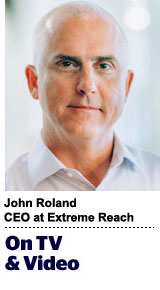 “On TV And Video” is a column exploring opportunities and challenges in advanced TV and video.
“On TV And Video” is a column exploring opportunities and challenges in advanced TV and video.
Today’s column is written by John Roland, CEO at Extreme Reach.
Fox Sports recently introduced six-second TV ad spots during live sporting events with plans to sell them throughout the NFL season. While TV has long been dominated by the standard palette of 15-, 30- and 60-second spots, this embrace of the social media-born six-second ad marks a natural evolution for the medium. It’s also yet another sign of the convergence of the TV and video advertising worlds.
Around this time last year, I wrote that 15- and 30-second spots were here to stay. My point was that the standard linear TV formats that have proven to be the scalable workhorses of brand marketing would continue to be just that for a long time. By the end of football season, I think we’ll have a good idea whether the six-second ad is likely to experience a similar longevity.
I don’t anticipate all future brand stories being told in sound bites, and I think that the robust, narrative style of storytelling popular with longer viral ads – Heineken’s nearly five-minute-long #OpenYourWorld ad is a prime example – is alive and well. In fact, the addition of this new mini-size ad unit simply underscores that a great story, well-told, doesn’t always happen in the same “container” for every product, service and situation. And how wonderful for the creative side of our business that there’s a new, scalable option.
This is the ad business, after all, and brand advertisers are always looking for new ways to be creative and connect with audiences at scale. In the late 1960s, it was the 60-second ad that reigned supreme on television screens. Everyone thought you couldn’t possibly tell the whole story in anything less than a minute. Then, when pushed to do just that for efficiency’s sake, creative teams rose to the challenge, and the 30-second ad became the norm. And of course, the 15-second ad then appeared in 1985, in an effort to better mimic the “fast-paced” viewing experience that the “MTV generation” had come to expect.
In 2014, 29% of ads were 15 seconds. In the first quarter of 2017, this number rose to 36%. This embrace of the shorter ad format should come as no surprise. Earlier this year a comScore study confirmed the ever-shortening attention span of consumers, finding that millennials, on average, watch ads for less than six seconds. At this rate, it seems natural that six-second ads will become the next new canvas for creativity.
The magic of this new format is that the infrastructure, buying methods and measurement standards already exist. It’s simply a new size offered on the good old TV. Same package, new size.
But, just as TV has taken an idea from the video world with this move, so too are video advertisers open to taking a page from TV’s playbook. Twitter and Instagram used to have six-second limits on their pre-roll ads, only recently opening up their platforms to 30- and 60-second spots. Snapchat, in an effort to bring bigger brands to its platform, now allows a wide range of lengths, from its ubiquitous 10-second spot to 15-, 30-, 60- and even 90-second ad placements available for brands looking to explore the creative limits of the platform.
This reciprocity is great news for marketers and their agencies who hotly pursue screen-agnostic strategies and need to leverage their existing creative assets easily across any screen and device. At the end of the day, customizing ads for individual platforms is a huge budgetary burden. Converging campaign styles across formats is a logical step for brands and advertisers looking to meet their target audiences wherever they are watching.
I would expect other TV entities to follow suit now that Fox Sports has opened the door to a new ad unit. And the TV industry will undoubtedly benefit from offering advertisers a new product line. New, millennial-focused brands that have built the bulk of their advertising efforts off of social media spots will now be able to use this same content, at a lower price point, to reach a whole new audience. Television remains unmatched in its ability to achieve reach and frequency, and the lower cost of producing and buying six-second spots may open the door for new kinds of TV advertisers.
I expect consumers will respond well to the new six-second ad format inside the TV viewing experience. Not only does it appeal to shortened attention spans, but perhaps six-second ads will mean commercial breaks get shorter, which in turn could keep viewers engaged and in their seats. At the end of the day, introducing new products and packages to TV marketers and audiences is a sign of continued innovation across all screens.
Follow Extreme Reach (@extremereach) and AdExchanger (@adexchanger).













